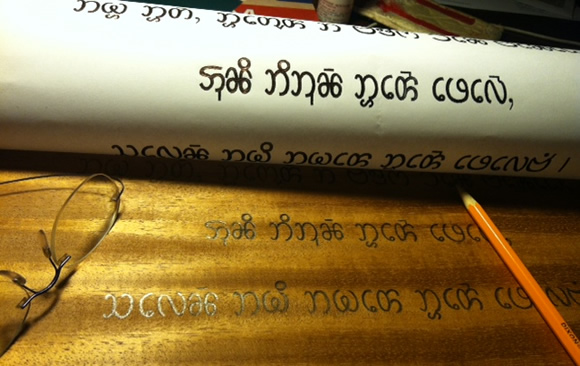Today we have a guest post by Tim Brookes, founder of the Endangered Alphabets Project.
As some of you know (in part because Simon has been kind enough to publicize my work on Omniglot), I’ve been spending the past three years gathering texts in writing systems that seem in danger of extinction, and then carving those texts in gorgeous pieces of wood, as a twin act of preservation and celebration.

Text in Mro
Now a new and urgent Endangered Alphabets situation has arisen, in a region of southern Bangladesh called the Chittagong Hill Tracts. This upland and forested area is home to 13 different indigenous peoples, each of which has its own genetic identity, its history and cultural traditions, and many of which have their own language and even their own script.
All these languages and scripts are endangered. Schools use Bengali, the official national language, and an entire generation is growing up without a sense of their own cultural history and identity. This is very much the kind of situation that has led to the loss or endangerment of hundreds of Aboriginal languages in Australia and Native American languages in the US. And this loss of cultural identity is closely connected to dropout rates in schools, unemployment, poor health—all the signs of cultural decay and collapse.
The Endangered Alphabets Bangladesh project is an attempt to provide a creative solution to this issue before these languages and scripts are among the estimated 3,000 languages that by mid-century will be lost forever.

Maung Nyeu
I’m trying to help by starting a Kickstarter fundraising campaign and forming a coalition of artists and academics from Harvard, Yale, Cambridge, Oxford and Barcelona. We’re going to be working with an extraordinary young man named Maung Nyeu.
Largely self-educated because he couldn’t speak the Bengali used in school, Maung left Bangladesh and got into the University of Hawaii, where he studied engineering so he could go back to the Chittagong Hill Tracts and build a school where indigenous peoples could be educated in their own languages. Now he has come to Harvard to get a graduate degree in education so he can create something unique: children’s schoolbooks in these endangered indigenous languages.
He says, “I’m trying to create children books in our alphabets – Mro, Marma, Tripura, Chakma and others. This will help not only save our alphabets, but also preserve the knowledge and wisdom passed down through generations. For us, language is not only a tool for communications, it is a voice through which our ancestors speak with us.”
We’re trying to help him by combining three artistic disciplines: carving, calligraphy and typography.

Text in Chakma
The first step is for me to create a series of beautiful and durable carved signs in the languages and scripts of these endangered cultures, and add them to the traveling exhibitions of the Endangered Alphabets Project. Each carving will feature a short poem I wrote for the purpose. It goes:
These are our words, shaped
By our hands, our tools,
Our history. Lose them
And we lose ourselves.
Our coalition, which includes a typographer and a calligrapher, will create some beautiful script forms of these endangered languages, then convert them into typefaces that can be used to print the books for Maung’s school.
At the moment, everyone is putting in their time on a volunteer basis, but my goal is to raise $10,000 to cover material costs, and to go a small way toward paying for the time, work, travel, shipping and printing involved.
If we can raise these funds, the outcome will be the first sets of children’s schoolbooks ever printed in Mro, Marma, Chakma, and other endangered languages of Bangladesh.
If you’d like to help, please visit the Kickstarter For Bangaldesh site, or pass this link along to others who might want to help.
Thanks!
Am just curious. Does each language have a different script and is Tim going to carve signs for all 13 languages ? I thought some of them used the Burmese script and the Roman script.
Each language does have it’s own script, though they also use other scripts.
Very cool. This guy’s from my city and I saw him give a talk and display some work sometime last year (when you had previously mentioned it).